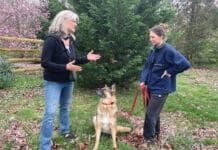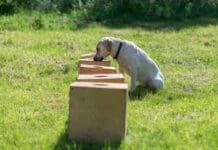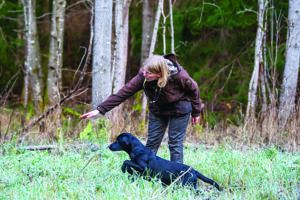
Ever hear of force-free gundog training? Neither have most of America’s 3 million duck, pheasant, and migrating bird hunters, but what’s new in the world of hunting dogs can improve your training methods, your dog’s behavior, and your relationship with your dog – even if you don’t have a gun or any interest in hunting.
Positive-reinforcement or force-free training methods were revolutionary 40 years ago, but now they’re familiar in obedience, agility, the show ring, and even the dog park. In contrast, force-free methods are seldom used by hunters in the U.S., where the use of ear pinches, choke chains, prong collars, and electric shock collars are still the norm.
However, change is in the air. Some trainers specialize in force-free gundog training, and their classes attract family dogs as well as prospective hunters. That’s in part because gundog trainers are attuned to the behaviors of spaniels, pointers, retrievers, setters, and other dogs bred to flush, point at, chase, or retrieve birds or small game.
Jo Laurens, author of the book Force-Free Gundog Training, notes that most people who live with dogs from hunting breeds don’t work them. “Due to their genetics and pedigrees, these dogs still have the instincts and desire to hunt but, unlike working gundogs, they have no structured outlet for this,” she says. “It’s a mistake for people to assume that if they don’t plan to hunt, they don’t need gundog training. This belief leads to out-of-control dogs and in turn to a restricted and impoverished life for dogs who aren’t allowed off-leash at all.”
Dogs find their own ways to pursue what they find reinforcing. “This,” she says, “leads to dogs who are more interested in the environment (scent, game, critters) than in their handlers’ reinforcers (praise, food, toys) – which means that many handlers struggle with control issues and with dogs who ignore recalls, chase after animals, or pay no attention when they find something interesting to sniff.”
Laura Hill, author of Advanced Retriever Training, agrees. “I advocate working with the dog’s natural abilities and instincts rather than against them,” she says. “The techniques and exercises I describe in my book will help owners understand the dogs in front of them, their motivations and desires, and it will also guide people to help their dogs manage their own behaviors rather than us imposing our will onto the dogs. Nurturing impulse control and self-control is important so that the dogs learn to manage themselves and make appropriate choices.”
Because dogs are genetically programmed to hunt, the same reward-based training methods are appropriate for all dogs with hunting behaviors, not just the breeds most associated with that activity.
FORCE-FREE DOG TRAINING
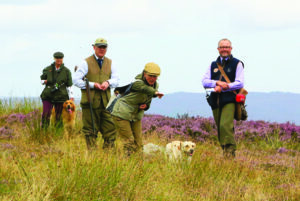
Photo Courtesy Laura Hill
Force-free or positive-reinforcement trainers focus on well-timed rewards for incremental improvements in exercises designed around the dog’s interests and abilities. They don’t use punishments like scolding, hitting, ear pinching, electric shocks, rattle bottles, lead jerks, dragging, lifting, pushing, pulling, nose tapping, or other “corrections.”
Still, ear pinches and shock collars are so entrenched that most bird hunters are reluctant to abandon them. In field trial and hunting circles, positive-reinforcement training is perceived as unproven and too permissive to be reliable, resulting in soft or spoiled dogs who don’t perform well.
In his book Absolutely Positively Gundog Training, Robert Milner describes how he was asked to help Tennessee Task Force One rebuild its search-dog program after 9/11. Milner’s first training results were disappointing, so he looked for the cause. “The people were motivated and smart,” he explains. “The dogs were motivated and smart. I was an experienced and successful trainer of dogs and people in other areas. The compulsion-training model appeared to be the culprit.”
To change their approach, he and 15 search-dog handlers attended a three-day Karen Pryor Clicker Training Conference. Clicker training instructors followed up with individual coaching. “The resulting training progressed rapidly,” says Milner. “We reduced the initial projected 18 months for compulsion training to six months for positive training. That was a 300-percent reduction in learning curve for novice trainers. That told me that positive training is three times easier for a novice trainer to master.”
By 2015, Milner had proofed his positive-training model on over 200 gundogs with good results. He applied the same training methods to disaster search dogs and scent detection/explosive detection dogs with equal success, establishing that with reward-based training, dogs learn quickly, perform well, and retain their skills over time.
Two years ago, 63 dogs with off-lead behavioral problems were divided into three training groups of 21 dogs, each receiving 2.5 hours of training over five days to improve recall and general obedience. One group was trained by manufacturer-nominated electronic-collar trainers who used electrical stimulation; another by the same expert trainers without the use of electronic collars; and the last group by independent, professional trainers using positive reinforcement.
The researchers concluded, “Our results demonstrate, through direct evidence from real life situations, that the reward-focused training was, indeed, more efficient than methods which included potentially aversive stimuli such as electric stimuli or excessive lead pressure.”
For details, see “Efficacy of dog training with and without remote electronic collars vs. a focus on positive reinforcement,” by L. China, D. Mills, and J. Cooper, in Frontiers of Veterinary Science, July 22 , 2020.
FORCE FREE DOG TRAINING FUNDAMENTALS
Introductory gundog training is like basic obedience, though gundog trainers provide different descriptions and explanations. For example, anyone carrying a loaded shotgun will want a hunting dog to remain calm, steady, and in a safe position on the handler’s left.
While novice handlers are often inconsistent in their voice commands (from the dog’s perspective, “come” is not the same as “here,” “here now,” or the dog’s name, which many owners use interchangeably), gundog trainers emphasize consistent verbal commands, well-timed whistle blasts, and hand signals that improve handler-to-dog communication. Fundamentals include:
- Sit or Hup. The dog sits and stays beside the handler or partway to the object being retrieved. A prolonged single whistle and raised hand give the same instruction.
- Come or Here. The dog comes to the handler. Multiple quick whistle “pips” are a recall signal.
- Heel. The dog walks beside the handler.
- Place. The dog returns to a board or elevated plank, sits, and waits.
- Release. The dog’s name, “okay,” “done,” “go,” or another release word lets the dog return to hunting or another activity after completing a task.
- Fetch. The dog retrieves a ball, bird, or other object and returns it to the handler.
- Deliver to hand. The dog drops the picked-up item into the handler’s hand.
REWARDS FOR DOG TRAINING
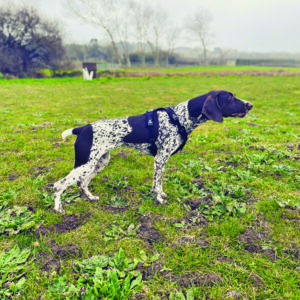
Rewards are essential in force-free training, and the definition of a reward depends on your dog. A reward should be something you provide instantly, not after several minutes, and it should be something that satisfies and motivates your pup. Common rewards in gundog training include food treats, tug toys, retrieves, games, attention, praise, and actual hunting.
“We’ve met many dogs who aren’t interested in training because it hasn’t been enjoyable,” says Elsa Blomster, co-author of Retrieving for All Occasions. “But when the handler finds the right reward (usually something really yummy such as minced meat, soft cheese, or a soft, fluffy toy), the dog doesn’t want to stop working.
“One of my online students struggled with the stop whistle because her dog didn’t respond at all, just continued sniffing the ground. We decreased the distance and had her put some kibble on the floor. When the dog finished sniffing, the handler blew the whistle and rewarded the dog for sitting, then she put some new kibble on the floor and let her sniff again.
“After a few repetitions, she blew the stop whistle just before the dog was finished, and this time the dog lifted her head and sat straight away. For that she received some cheese, which was a higher-level reward. We gradually increased the distance and did the same thing with other distractions, such as with game scent or whatever the dog found distracting.”
USING PLACE BOARDS
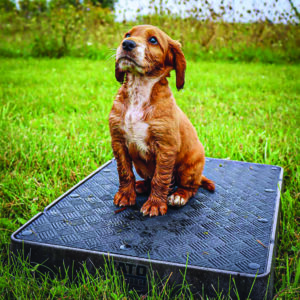
Trainers who use them swear by place boards, which can be anything from a piece of plywood to an elevated deck with a non-skid surface. A place board acts as a safe “home base” that is itself a reward, one that helps the dog develop patience and steadiness while learning voice, whistle, and hand signals.
When Jordan Horak, designer of the Cato Board, was introduced to place boards nine years ago, he was struck by how quickly his dogs gravitated to the boards.
“I began adapting the place board training and developed drills that the dogs not only enjoyed but that gave me a rapport and control that I’d never experienced before,” says Horak.
In 2018, Horak and two of his Cocker Spaniels won American Kennel Club Spaniel Field Trial National titles, for which he credits positive-reinforcement training and board practice. “Although I initially expected Cato Boards to be used primarily by gundog owners, most of our customers use them for family dogs or dogs involved in agility, basic obedience, tricks, police work, or the military,” he says.
ONE STEP AT A TIME WHEN FORCE FREE DOG TRAINING
An essential part of force-free training is breaking tasks into small pieces, presenting those pieces one at a time, moving slowly and staying with each item until the dog understands it, rewarding the dog for each success, and reviewing steps in future sessions. Short rather than lengthy practice sessions, gradual progression from simple toward more challenging behaviors, and patience help as well.
Is your dog having fun? Are you? If not, reconsider your methods and put fun back into your sessions.
We’ve compiled a long list of instruction books, online resources, and videos that offer step-by-step guidance through every phase of force-free gundog training, from the basics to blind retrieves, directional work, reliable whistle recalls, water retrieves, advanced instructions, field trials, and more.


